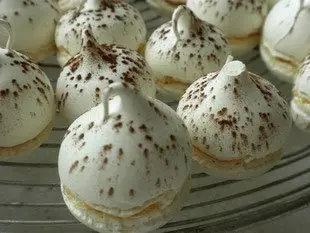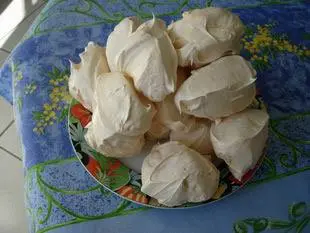This site uses only a few technical cookies necessary for its operation. By continuing to browse, you accept their use.
To find out more...
To find out more...
The 3 kinds of meringue

Meringue – what could be simpler? Just beaten egg whites with sugar added. This makes a fairly stiff mixture which can then be cooked in a cool oven to create those lovely, light confections.
But in the world of professional patisserie, meringue comes in three different kinds. Even if the principle is the same (egg whites + sugar), the results are quite distinct and lend themselves to different uses.
But in the world of professional patisserie, meringue comes in three different kinds. Even if the principle is the same (egg whites + sugar), the results are quite distinct and lend themselves to different uses.
64 K 4.5/5 (22 reviews)
Keywords for this post:PastryMeringueFrenchItalianSwissEgg whitesBeatenLast modified on: June 14th 2013
The 3 kinds of meringue
French meringue

This is the simplest, the easiest to make, your basic meringue. The egg whites are beaten until stiff, then caster sugar (50 g per egg white) is folded in. It's not difficult, you can let children help (they love it) and this makes very light, fluffy meringues.
Swiss meringue

The method for this is a bit different: the egg whites and caster sugar are mixed together at the start , then heated to 50°C over a bain marie before beating. This makes rather denser meringues, the sort often used to make decorative items (mushrooms, etc.) to add a finishing touch to desserts and cakes (Christmas logs, for example). If you buy meringues from a French baker, they are generally the Swiss type.
Italian meringue

Italian meringue is the most complicated: the egg whites are beaten as usual, but the sugar is cooked to the hard-ball stage (120°C) before being added to the egg whites. This makes a very smooth meringue, often used as the base for other recipes, such as nougat glacé (frozen nougat) or a pear and lime meringue pie.
To sum up
As you can see, it's all a matter of temperature (well, almost), as the basic mix of egg whites and sugar is the same. Do remember, though, that even if a particular meringue is better suited to certain recipes, in practice, you can choose whichever type suits you.
Lasts posts
Butter vs. grease
We often read in a recipe where a pastry is put into a mould that, just before pouring, the mould should be buttered or greased. But what's the difference between these 2 terms?December 1st 20257355
Getting out of the fridge early
Very often when you're cooking, you need to take food or preparations out of the fridge, to use them in the recipe in progress. There's nothing tricky about this: you just take them out of the fridge and use them, usually immediately, in the recipe. But is this really a good method?November 24th 20259855
Who's making the croissants?
When you look at a bakery from the outside, you naturally think that in the bakery, the bakers make the bread, and in the laboratory, the pastry chefs make the cakes. It's very often like that, with each of these professions having quite different ways of working, but sometimes there's also one...November 23th 2025886
Oven height
When we put a dish or cake in the oven, we naturally tend to put it on the middle shelf, and that's what we usually do. But in some cases, this position and height can be a little tricky, so let's find out why.October 8th 20252,5085
The importance of sieving
In recipes that use a fine powder (flour, powdered sugar, etc.), you'll often see the advice to sift before using it. To sift is to pass the powder in question through a sieve (a very fine strainer) before incorporating it into your recipe. It's often advice, but is it really useful?September 3rd 20257,3813
Other pages you may also like
Unmoulding cakes while hot
When you make a cake, pound cake or whatever (what bakers call a "travel cake" because it's easy to carry around) you've most likely made a batter, either by hand or in a food processor, which you then pour into a buttered pan. It's a classic, and I've already talked to you about 2 or 3 tips on...February 6th 202138 K4.6
Drawing a pattern in pastry
Often in the kitchen, in pastry-making, or in baking, we need to trace a pattern on a pastry. It's just a question of aesthetics but it has its effect after baking on a galette, pithiviers, pâté en croute (terrine in a pie crust), etc.May 23th 201935 K4.1
Tranché, dissociated, failed, in short... missed!
When preparing a sauce or a cream, there's always a (small) risk that the creamy preparation you're working on will suddenly separate into two parts of different textures: a liquid part, for example, and a more or less solid part, or even become lumpy. It's terribly frustrating, but we'll see...June 19th 202312 K5
85 grams of eggs?
Some time ago, I already spoke to you about the difference between baking and pastry-making, I emphasized, among other things, the precision of pastry-making which requires grams, cm, degrees and minutes. That's why, on the one hand, you have baking and cooking, where a certain tolerance is...November 26th 201856 K4.6
Travel cakes
You may have come across the term "travel cakes" ("gateaux de voyage" in french) for certain pastries, so let's take a look at what they're all about.January 27th 20256,979
Post a comment or question
Follow this page (as 3 people already do)
If you are interested in this page, you can "follow" it, by entering your email address here. You will then receive a notification immediately each time the page is modified or a new comment is added. Please note that you will need to confirm this following.
Note: We'll never share your e-mail address with anyone else.
Alternatively: you can subscribe to the mailing list of cooling-ez.com , you will receive a e-mail for each new recipe published on the site.









